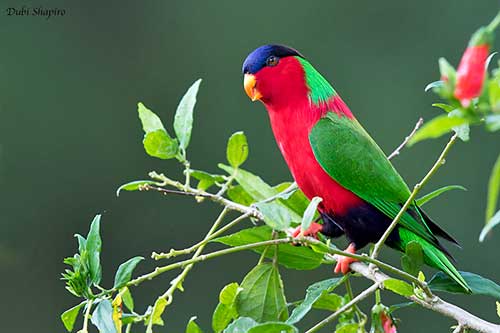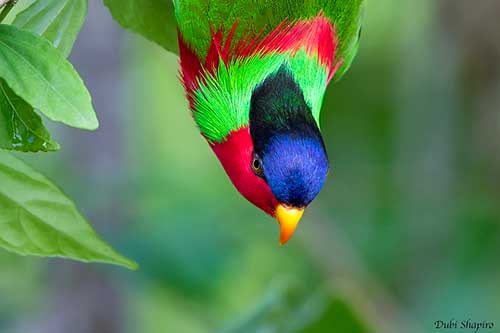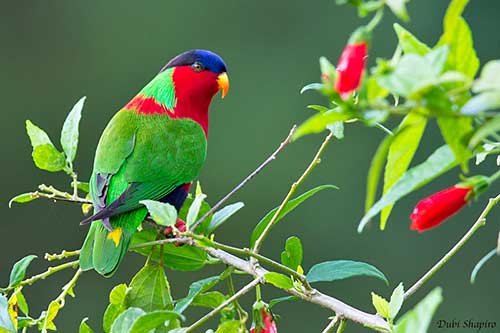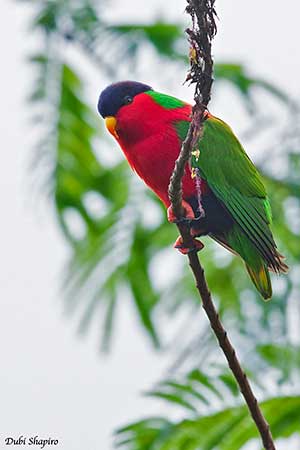
Fr: Lori des Fidji
Ang: Collared Lory
All: Einsiedlerlori
Esp: Lori Solitario
Ita: Lori dal collare
Nd: Gekraagde Lori
Sd: kraglori
Photographer:
Dubi Shapiro
Dubi Shapiro Photo Galleries & Dubi Shapiro's Pictures on IBC
Text by Nicole Bouglouan
Sources:
HANDBOOK OF THE BIRDS OF THE WORLD vol 4 by Josep del Hoyo-Andrew Elliott-Jordi Sargatal - Lynx Edicions - ISBN: 8487334229
PARROTS OF THE WORLD – An Identification Guide – by Joseph M. Forshaw – Princeton University Press – ISBN 0691092516
L’ENCYCLOPEDIE MONDIALE DES OISEAUX - Dr Christopher M. Perrins - BORDAS - ISBN: 2040185607
Wikipedia, the free encyclopaedia
Wikipedia, la enciclopedia libre
THE AVIANWEB - Beauty of Birds (Sibylle Faye)
Southeast Texas Avian Rescue - The Collared Lory
NationalPedia - Collared Lory: National Bird of Fiji
National bird of Fiji, the Collared Lory, is featured on country’s first titanium colour coin
Collared Lory
Phigys solitarius
Psittaciformes Order – Psittaculidae Family
INTRODUCTION:
The Collared Lory is the national bird of Fiji and endemic to these islands where its local name is “Kula”. It is native to the northern parts of the Lau Archipelago in addition to the Fiji Islands. Its name derives from the green and red feathers of both mantle and nape, which are slightly longer than rest of plumage.
The Collared Lory is mainly found in forested areas, but it has also adapted to urban landscapes. It feeds on seeds, fruits and small caterpillars.
The species has restricted range in which it is common and the population is currently stable and not globally threatened.
DESCRIPTION OF THE BIRD:
Biometrics:
Length: 20 cm
Weight: 75-85 g
The Collared Lory has dark purple forehead, lores and crown, whereas the nape shows elongated bright yellow-green feathers tipped with red.
On the upperparts, back, wings and tail are green, but the rump is mostly yellowish-green. The central rectrices are shorter than the outer feathers.
On the underparts, cheeks and ear-coverts to throat and upper belly are red. Thighs and lower belly are deep purple. The undertail-coverts are green.
The bill is orange. The eyes are orange-red. Legs and feet are pinkish-orange.

The female resembles male, but she has paler, more bluish forehead, and the hindcrown is slightly washed green.
The juvenile shows some bluish-purple bars on breast and upper belly. The hindcrown is dull purple with duller green non-elongated feathers. There is little or no dull red at tips.
The bill is brown. The eyes are pale brown. Legs and feet are greyish-brown.
RANGE:
The Collared Lory can be found on the larger islands of Fiji group, and also in northern Lau Archipelago.
HABITAT:
The Collared Lory is common in most forested habitats with flowering trees, but it also frequents mixed plantations, garden with coconut-palms, and tree-lined streets in the urban areas of Suva. It is mainly found in subtropical or tropical moist lowland wooded areas, but the species is less frequent in cultivated fields.
CALLS AND SONGS: SOUNDS BY XENO-CANTO
The Collared Lory gives shrill, screechy two-note calls with more prolonged second note. This call is usually given in flight.
While perched, it produces monosyllabic shrieks “tzreet”.
BEHAVIOUR IN THE WILD:
The Collared Lory feeds on seeds, fruits, nectar and blossoms, and small caterpillars. It favours flowering trees such as coconut-palms, Erythina and Spathodea trees. In coconut-palms, it alights out of fronds and performs fluttering hops to descend to the flowering stalks. It is always very active, flying constantly from branch to branch, or moving quickly from one flower to the next. It is often seen hanging upside down while feeding.

The Collared Lory is usually seen in pairs or in small groups of 5-8 individuals, but large flocks are often formed around flowering trees. They may become aggressive when feeding, and drive off other birds, and especially honeyeaters, by biting their wings.
The courtship displays of the Collared Lory are unknown. But we can suggest that the elongated green and red nape feathers are used in displays when they are fanned on each side of the head.
Like most Psittaciformes, it nests in natural cavities, often holes in trees. Both adults share the nesting duties, and they form strong pair bonds.
The Collared Lory performs seasonal movements related to food availability, and especially when Erythina trees bloom in August-September.
The flight is fast and direct with rapid wingbeats producing audible whirring noise. This strong flier often performs long daily flights between the roosts and the foraging areas.

REPRODUCTION OF THIS SPECIES:
The breeding season occurs between July and December.
The Collared Lory nests in cavities, a hole in coconut-palm or in rotten dead stump. From some observations, it may also nest in the hole of a rotting coconut still attached to the tree.
The female lays two eggs. Both parents share the incubation during four weeks. The chicks are fed by their parents during 8-9 weeks, prior to fledging.
The nest is strongly defended by both adults against other birds.
This species also breeds in captivity.
PROTECTION / THREATS / STATUS:
The Collared Lory is common throughout wooded habitats, but it has restricted range in just few islands.
It might be threatened in future by disturbance, including logging that destroys the nesting trees. However, this species is adaptable and exploits introduced tree species for food, allowing these birds to persist in spite of changes in the habitat.
The population is stable and the Collared Lory is currently evaluated as Least Concern.
